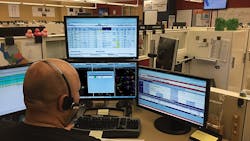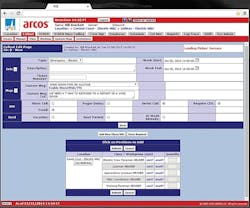Crew Availability Unites Union and Utility
Implementing an enterprise software application is an unlikely way to build a bond between utility management and a union, but this is exactly what has happened at Pacific Gas and Electric Co. (PG&E). In 2012, the utility launched a technology pilot designed to automate the callout and assembly of crews needed for power restoration and gas leaks. The pilot concluded in January 2014.
In June 2014, PG&E brought all of its first-responder yards and substations on-line with the automated callout system. By early 2015, the utility’s maintenance and construction group along with its transmission line organizations were using automated callouts for emergencies handled by employees belonging to IBEW Local 1245 and Engineers and Scientists of California Local 20, and filling daily shifts by dispatchers.
Implementing Consistency and Standardization
In the manual callout process, crews’ phone numbers and pagers were recorded on paper. When an after-hours emergency occurred, supervisors would take their paper lists and call for crews. As they called, the supervisors would take notes by hand when workers responded. Across PG&E’s 68-plus construction yards, there are likely many ways in which supervisors interpret the 212 list, which is the contractual section of the union agreement related to emergency overtime. However, there was simply no consistency in how calls were made across the many yards. This led to overtime grievances when, for example, callout requests could not be filled at the initial yard and the order in which supervisors made calls (or chained requests) to other yards’ crew members varied constantly.
Deployment of the automated system is an example of technology helping to drive process consistency and standardization. Furthermore, although the manual callout process worked, it was hardly efficient. For instance, with the manual process, it could take a PG&E supervisor 30 minutes or longer to fill a callout request. It was often difficult to reach a lineman or troubleman on the first try. And, if a lineman did pick up a call on the first ring, he wanted to discuss the callout and know with whom he might be working. Manual callout was inefficient and took away from the supervisor’s productive time.
After benchmarking several automated callout systems a few years ago, including one called ARCOS in use at Alabama Power, PG&E was certain there was a better way. In the summer of 2012, with the intent of piloting ARCOS, PG&E set up a system development workshop to understand the nuances of the callout process.
Members of the utility’s business applications and mobile technologies organizations met with IBEW Local 1245 for two-and-a-half days to collect data. The union thought PG&E’s callout process was tremendously complicated. PG&E agreed with that assessment. Some in the group thought there was no way to automate callouts effectively. Like other utilities ARCOS had worked with, PG&E thought its contract was too difficult for software programmers to figure out. According to ARCOS, PG&E was not the first utility to feel that way.
Establishing a Dialogue
Before the pilot even kicked off, PG&E managers and union representatives established weekly conference calls. This was a departure from past initiatives where the communication entailed telling employees a change was coming, describing the process, and expecting widespread adoption and acceptance. Instead of the past approach, the weekly conference calls and other meetings were used to exchange ideas and concerns. The frequent meetings and open discussions ensured both sides genuinely knew the other side was willing to listen to each group’s suggestions.
During the last week of August 2012, the automated callout pilot was launched across the Sierra division. A week later, a second pilot was kicked off across the Kern division. These divisions were selected for their wide range of geographic and weather conditions. The total number of end users involved with the pilot across both divisions was 553 employees.
As presentations were conducted about the pilot to the workforce in these divisions, management and union remarks were delivered jointly to employees. Because of that approach, many worries about automated callout were eased. Everyone’s takeaway from the pilot was this: an automated callout is much more efficient than human callout.
For example, automated callout tracks around-the-clock, real-time status of crews. It is a human capital management tool. Here is why. There is visibility as to who can and cannot work. The system tracks how many times an employee refuses a callout, which is important for equitably distributing work per the union agreement. The callout system also allows the user to input the estimated repair time. Unlike the manual callout process, management and union representatives can now see the current rotation and any worker’s status.
Understanding without Bartering
Automated callout also eliminates a lot of the bartering that went on between supervisors calling for crews and employees responding to requests. When an outage occurs, an administrator turns to the automated callout system, which contacts responders while following the union agreement that is in place. As employees are called, paged or e-mailed, the system describes the restoration work. Crews get an understanding of the nature of the work, but there is no discussion about the assignment or who is on the crew.
The automated system can also track crew size to assist dispatchers with tracking personnel assignments.
Creating Transparency
This process has brought the union and PG&E together around crew availability. There is a transparency that was not there before because everyone is a stakeholder now. Working together on this oversight committee, four union and nonunion members met biweekly to answer questions about the transition to automated callout and support requests for information.
Jason Regan, director of emergency management preparedness for PG&E, and Stephanie Carstairs, a program manager for PG&E, have worked with the committee to compare the manual callout process across yards and standardized callout practices in contracts, logistics and across lines of business. For example, Regan’s team learned 15% of yards are consistent with their application of callout by working with the ARCOS system to highlight processes and show how each yard compares and contrasts in its approach.
Through the automated callout system, PG&E can create rosters for restoration work across all 68 yards in spreadsheets and share this with the union to verify callout preferences are set up. This is now codifying inconsistent callout practices found in letters of agreement and differentials across the utility, and integrating that into ARCOS. Some of these inconsistencies can be the result of contracts or schedule changes, but the goal is for everyone to move toward one automated system.
This is because management, union and members now see who is regularly available or unavailable for work. This leads to a reduction in grievances related to callouts. When there are concerns about the actual callout process, the ARCOS reports provide very detailed, clear and concise information. This has proven to reduce disputes and grievances as well as the associated administrative time on both the utility’s and union’s part.
In the divisions where the pilot was launched, there was a mutual benefit to seeing how the callout is done. The business representatives in the divisions where the automated callout is running say there has not been a single grievance on overtime, while other divisions not using the system have had some bypass pay issues.
Improving Customer Service
Customers are realizing the benefits of this collaboration as well. Callouts are being completed about 60% faster than with the manual system. On average, this equates to about a 10-minute to 20-minute response per callout versus the 30-minute to 60-minute response supervisors in Sierra and Kern had spent filling callouts prior to the pilot. Some callouts for first responders are filled in less than 3 minutes.
The accuracy that is now achievable with callout availability helps management and unions to focus on a common enemy — outages and leaks. Tackling these issues together is in the best interest of customers. Automating the callout process has promoted a focus on the shared duty to respond safely, quickly and equitably to unplanned events.
Gary Cassilagio ([email protected]) is director of business applications for Pacific Gas & Electric Co. He is responsible for distribution grid, mobile and smart grid technology supporting electric distribution operations. Cassilagio began his career at PG&E with the electric construction group in 1981.
Tom Elder ([email protected]) is the mobile technology manager in the business applications organization within electric operations. He is responsible for the development and deployment of mobile computing technologies to the Pacific Gas & Electric field workforce. Elder has managed significant projects that have included business process improvements, work efficiency and mobile computing across multiple lines of business within PG&E.
Bob Gerstle ([email protected]) was hired as a business representative by IBEW Local 1245 in 2012 and is currently an assistant business manager for the union. His electric utility industry experience includes 33 years as a lineman and crew foreman.
Editor’s note: Participants of the 2012 system development workshop, gathered to understand the nuances of the callout process, included Barry Anderson, Pacific Gas & Electric’s vice president of emergency preparedness and response; Gary Cassilagio, PG&E’s director of business applications; Tom Elder, PG&E’s manager of mobile technologies; Bob Dean, IBEW’s senior assistant business manager; Bob Gerstle and Dave Sankey, business representatives for IBEW Local 1245; and a team from ARCOS: Steve Brown, lineman from Auburn; Jeanette Stiedlmayer, M&C clerk from Grassvalley; Doug Gaither, electric dispatcher from Fresno; and Noemi Trevino and Jason Reed, substation; and Marc Garcia, mobile technologies.
Mentioned in this article:
ARCOS | www.arcos-inc.com
Pacific Gas & Electric | www.pge.com



